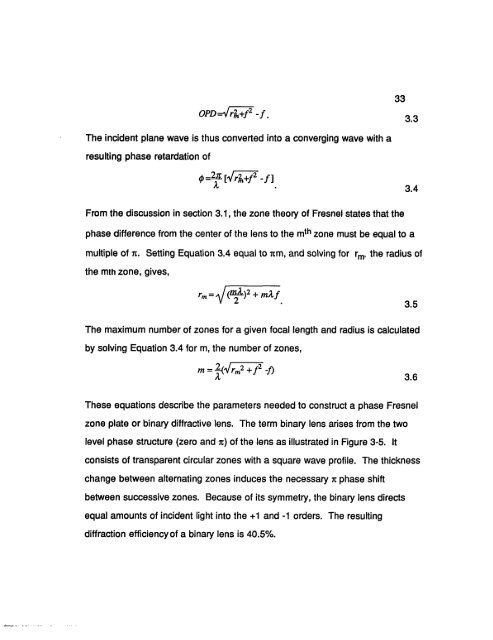azu_td_1349475_sip1_... - Arizona Campus Repository
azu_td_1349475_sip1_... - Arizona Campus Repository
azu_td_1349475_sip1_... - Arizona Campus Repository
You also want an ePaper? Increase the reach of your titles
YUMPU automatically turns print PDFs into web optimized ePapers that Google loves.
33<br />
OPD=Jrl+f 2 3 3<br />
The incident plane wave is thus converted into a converging wave with a<br />
resulting phase retardation of<br />
0=^[Vr2+/ 2 ./]<br />
A<br />
3.4<br />
From the discussion in section 3.1, the zone theory of Fresnel states that the<br />
phase difference from the center of the lens to the m ,h zone must be equal to a<br />
multiple of n. Setting Equation 3.4 equal to 7im, and solving for r m, the radius of<br />
the mth zone, gives,<br />
r m = J( a^-) 2 + mX~f<br />
V 2<br />
3.5<br />
The maximum number of zones for a given focal length and radius is calculated<br />
by solving Equation 3.4 for m, the number of zones,<br />
m=f 36<br />
These equations describe the parameters needed to construct a phase Fresnel<br />
zone plate or binary diffractive lens. The term binary lens arises from the two<br />
level phase structure (zero and jt) of the lens as illustrated in Figure 3-5. It<br />
consists of transparent circular zones with a square wave profile. The thickness<br />
change between alternating zones induces the necessary n phase shift<br />
between successive zones. Because of its symmetry, the binary lens directs<br />
equal amounts of incident light into the +1 and -1 orders. The resulting<br />
diffraction efficiency of a binary lens is 40.5%.
















